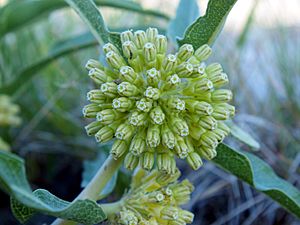Green milkweed facts for kids
Quick facts for kids Green milkweed |
|
|---|---|
 |
|
| Scientific classification | |
| Genus: |
Asclepias
|
| Species: |
viridiflora
|
Asclepias viridiflora, also known as green milkweed, green comet milkweed, or green-flower milkweed, is a type of plant found across a large area. It grows in many parts of the eastern and central United States, from Connecticut all the way to Georgia, Arizona, and Montana. You can also find it in southern Canada.
Green milkweed is a plant that grows upright, usually reaching about 50 centimeters (about 20 inches) tall. It has special greenish-white flowers that make it easy to spot. Unlike some other types of milkweed plants, its seed pods are smooth. They don't have the bumps or rough spots you might see on other milkweed pods.
Protecting Green Milkweed
Even though green milkweed grows in many places, it needs our help in some areas. It is listed as an endangered plant in Florida and Connecticut. This means there are very few of these plants left in the wild in those states. It is also listed as threatened in New York State, meaning it could become endangered if we don't protect it.
Traditional Uses of Green Milkweed
Native American tribes have used green milkweed for many generations. They found different ways to use this plant in their daily lives.
The Blackfoot people used the roots of the green milkweed. They would chew the roots and then place them on swollen areas or rashes, like those caused by diarrhea. They also used it for sore gums in babies and for sore eyes. Chewing the root was also a way to help with sore throats. Besides medicine, the Blackfoot used the plant to add flavor to their soups and even ate the fresh roots as food.
The Brulé Lakota also used green milkweed, especially for children. They would grind the roots into a powder and give it to children who had diarrhea. Mothers would also drink a special tea made from the whole plant. They believed this tea helped them produce more milk for their babies.

